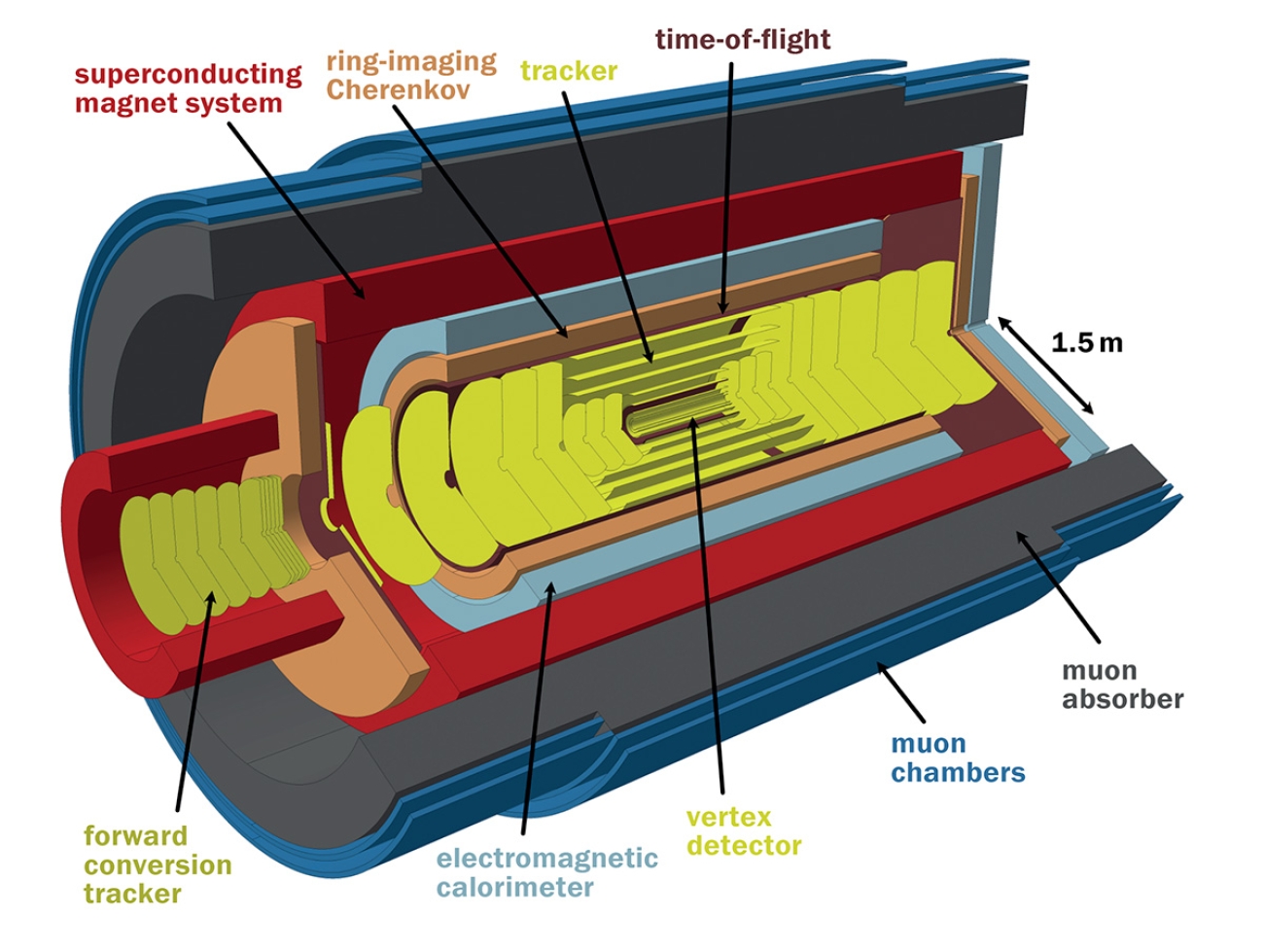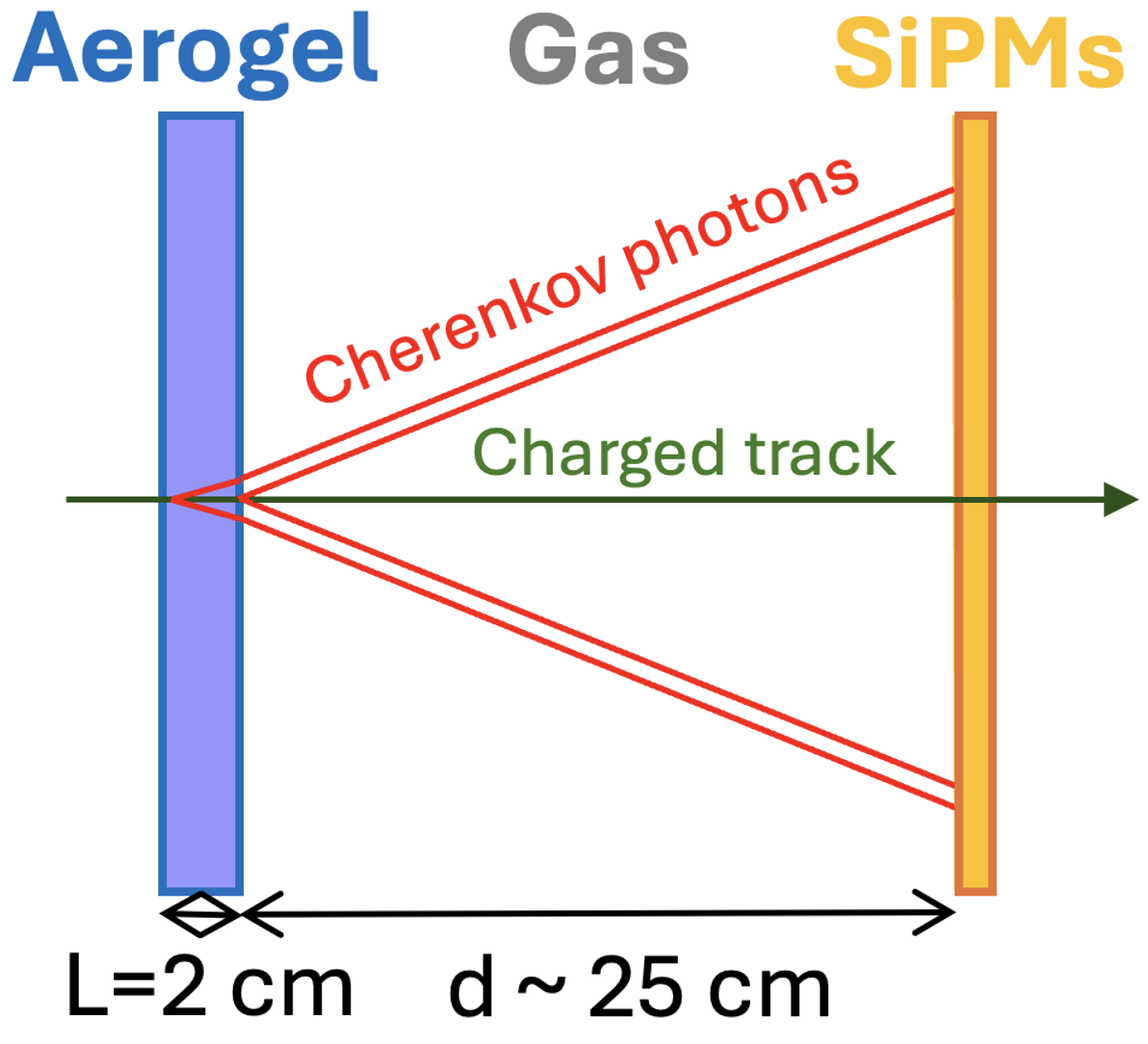Aerogel RICH detector for the future ALICE 3 PID system at LHC

For the LHC Runs 5, starting in 2036, the ALICE collaboration is proposing a new apparatus, ALICE 3 (CDS record), to further investigate the properties of Quark–Gluon Plasma (QGP) following the physics measurement campaign of LHC Runs 3 and 4. Despite significant progress, relevant unanswered questions could be addressed by fully exploiting the HL-LHC for QGP studies. Benchmark measurements include heavy-flavour probes and electromagnetic signals of the QGP, for which a comprehensive particle identification system is required.
A Ring Imaging Cherenkov (RICH) detector, employing an aerogel Cherenkov radiator coupled to the photodetector layer by simple proximity focusing (Fig. 1), will provide 3σ separation in the ranges 0.5–2 GeV/c, 2–10 GeV/c, and 4–16 GeV/c for e/π, π/K and K/p, respectively.

Figure 1: Schematic view of the proximity focusing aerogel RICH layout.
The ALICE 3 RICH system will consist of two subdetectors: a barrel RICH (bRICH) and a forward RICH (fRICH). The bRICH, surrounding the outer TOF barrel, will cover the pseudorapidity range |η| < 2.0, extending 7 meters in length with a radial span from 0.9 m to 1.2 m. The fRICH comprises two end-cap detectors covering the pseudorapidity intervals −4 < η < −2 and 2 < η < 4. The total active area is about 30 m2. To enhance the PID performance while minimising the required area, a modular projective cylindrical geometry has been devised for the bRICH (Fig. 2) A photon counter sensitive to the visible light and able to operate in the planned field of 2 T produced by a superconducting solenoid surrounding the RICH, has to be used for the detection of Cherenkov photons emitted by the aerogel radiator. Additionally, the requirements include high single-photon detection efficiency, low background noise, and the ability to operate after exposure to a radiation load of about 6.1·1011 1 MeV neq/cm2.

Figure 2: Schematic view of the projective cylindrical bRICH layout
The proposed photon detector consists of a layer of Silicon Photomultipliers (SiPMs) coupled to the Front-End Electronics (FEE) via an interposer made of ceramic implementing micro-channels for sensor cooling. The FEE is based on the DENEB ASIC, currently under development by the Turin and Bologna INFN Section for the DUNE experiment. The main goal of the ongoing R&D is the selection of SiPM sensors and the definition of operating conditions to cope with the large radiation load. Radiation damage results in increased Dark Count Rate (DCR) and reduced signal-to-noise ratio. In order to decrease the DCR, cooling of sensors down to −40 °C by flushing dual-phase CO2 in the interposer microchannels is being studied. Moreover, a SiPM in-situ annealing procedure with thermal cycles is under development to mitigate the radiation-induced damage.
Further R&D is devoted to the implementation of Time of Flight (TOF) measurement for charged particles, exploiting the SiPM layer of the RICH system thus resulting in a significant simplification of detector integration and reduction of total cost. The concept of the Cherenkov-based TOF system could be achieved by adding, in front of the SiPMs, a thin layer (1–2 mm) of solid Cherenkov radiator (e.g. SiO2, MgF2, or high-refractive-index glass) and exploiting the time information of the Cherenkov photons therein generated. The time resolution is proportional to 1/(Nph)1/2, where N is the number of fired SiPM cells, and could reach the required target of 20 ps for the expected values of N > 5.
The extension of electron identification up to momenta of approximately 4 GeV/ c, by introducing a Cherenkov radiator gas into the proximity-focusing gap, is under investigation within the ongoing R&D activities. The required refractive index is n ≈ 1.0006 and the proposed gas mixture is C5F10O/N2 (20/80%).
RICH prototypes have been successfully assembled using commercially available components and custom front-end boards (FEBs). They have been tested at the CERN-PS T10 beam line since 2022 (EPJC paper, JINST paper), showing results fully consistent with Monte Carlo simulations and compliant with the required PID performance. All tested prototypes consisted of a cylindrical vessel housing a Cherenkov radiator and a photodetector layer. The radiator, made of a 2 cm thick hydrophobic aerogel tile from Aerogel Factory & Co. Ltd. with a refractive index of n = 1.03 at 400 nm wavelength, was located 23 cm upstream with respect to the photodetector layer, which was equipped with SiPM arrays. A picture of the set-up tested in 2023 is shown in Fig. 3.

Figure 3: (Left) Photo of the beam test set-up at CERN PS T10 line in October 2023. The beam enters from the right side. (Right) CAD view of the RICH vessel with the aerogel tile and the endcap photon detector plate.
The performance of the prototype in terms of Cherenkov angle resolution has been evaluated. Figure 4 (left-handed panel) shows the distribution of the reconstructed single-photon Cherenkov angle for positively charged particles in an 8 GeV/c beam, obtained after applying the appropriate selection criteria. The two peaks for pions and protons are clearly visible and the obtained angular resolution is compliant with the expected performance. In Fig. 4 (right-handed panel), the expected improvement of the angular resolution as ∝ 1/(Nph)1/2 with the increasing number Nph of detected photon for the negative charged beam at 10 GeV/c is also shown. The experimental points are fitted with the expected 1/(Nph)1/2 scaling relative to the single photon angular resolution.

Figure 4: (Left) Distribution of the reconstructed aerogel single photon Cherenkov angle for the positive charged beam at 8 GeV/c momentum. (Right) Cherenkov angular resolution as a function of the number Nph of detected photons in the pion ring for the negative charged beam at 10 GeV/c in momentum, obtained from the 2023 prototype beam test.
In the 2024 prototype beam test (Fig. 5 left-handed panel) the timing performance of SiPMs equipped with a thin layer of solid Cherenkov radiator has been also evaluated. Figure 5 (right-handed panel) shows the measured resolution on the relative time between the charged particle hits in two different SiPM arrays equipped with 1 mm thick SiO2 window placed along the beam line. The obtained value of ≈ 46 ps, corresponds to about 30 ps at a single SiPM channel, accounting both the intrinsic SiPM contributions and the electronics.

Figure 5: (left) beam test set-up at CERN PS T10 line on Sep/Oct, 2024. The beam enters from the right side. The two insets show a schematic view of the RICH prototype inside the cylinders. (Right) Distribution of the time difference measured between two SiPM arrays in the 2024 prototype beam test.
The ALICE 3 RICH detector represents a significant technological advancement in particle identification capabilities for the HL-LHC era. Through a coordinated program of R&D studies and beam tests, the collaboration has already demonstrated the feasibility of key design choices, including the use of aerogel radiators and SiPM-based photon detection. The prototype results confirm that the RICH will deliver the angular resolution and efficiency required to meet the ambitious physics goals of ALICE 3.
